Things to do in Port Fairy, Victoria
This historic Victorian town has more than 50 cottages and civic buildings on the National Trust register.
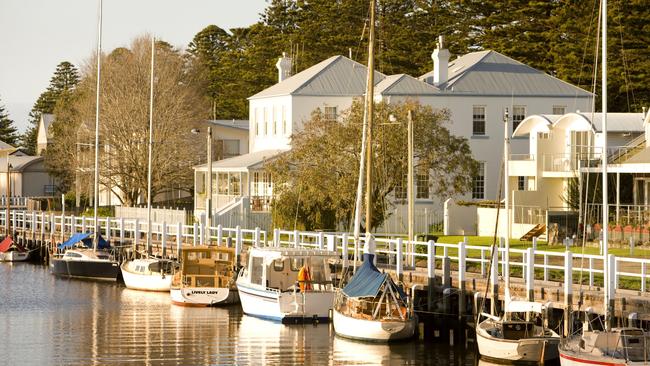
1 Tower Hill Wildlife Reserve, just 20 minutes east of Port Fairy, is Victoria’s oldest national park and an underappreciated treasure. Besides emus greeting visitors in the carpark, koalas cradled in eucalyptus trees and a constant, uplifting symphony of birdsong, the landscape itself feels ancient and eerie. The park circles an extinct volcano whose last eruption, more than 30,000 years ago, has left a fascinating legacy of lava tongues, wetlands and cliffs of layered ash. Visit the Robin Boyd-designed visitor centre, built from locally quarried limestone with a living roof of lichen and moss, for information and indigenous souvenirs. Then strike out along the park’s various pathways, including the Lava Tongue boardwalk and the Last Volcano hike to the lip of Tower Hill for views into the caldera’s black mirrored waters. The visitor centre also arranges guided tours, towerhill.org.au.
-
2 After the drive from Melbourne (3½ hours by the inland M1, six hours-plus along the Great Ocean Road), refreshments are in order. Pull into Basalt Wines at Killarney, about 10 minutes outside Port Fairy, where seventh-generation farmer Shane Clancey tends grapes beside the Southern Ocean. He produces more than half-a-dozen varieties, from standout rieslings to the gold-medal 2017 tempranillo. The cellar door and a new, 40-seat restaurant are inside a smartly converted tractor shed with picture windows over the pinot noir vines. Pair a Basalt wine with Spanish-inspired plates such as salt-cod croquettes or, for a true taste of the southwest, have the smoked Skipton eel with Killarney potatoes and smoked buffalino, from Shaw River Buffalo Cheese in nearby Yambuk;
basaltwines.com.au.
-
3 With more than 50 cottages and civic buildings on the National Trust register, few Victorian settlements match Port Fairy’s wealth of historic streetscapes. At 40 Gipps Street, for example, the rear of the circa-1834 Captain Mills Cottage is believed to be the oldest house in the state. But perhaps the town’s most impressive landmarks are its majestic Norfolk Island pines, first planted in 1848. The Port Fairy and Region Visitor Information Centre at 4 Bank Street has self-guided walking maps of the town’s historic buildings and its maritime heritage, and also runs guided tours on Saturdays at 11am.
-
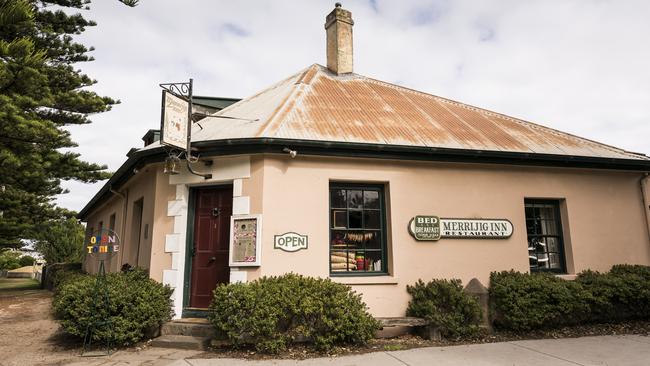
4 The Merrijig Inn has always played a central role in Port Fairy. Built in the 1840s, back when the riverside settlement was still known as Belfast, the pub initially doubled as a courthouse and police barracks. Today it’s the town’s most esteemed restaurant, both for the warmth of the welcome and for chef Tanya Connellan’s winning ways in the kitchen. Her menus, shaped by the seasons, local suppliers and the Merrijig’s own gardens, begin with house-baked breads and might segue into beef tartare showered with shaved, cured duck egg, seafood pulled straight from the Southern Ocean and Western District lamb. Drinks are equally lush, from house vermouth and barrel-aged negronis to a hefty winelist of modern French classics combined with current releases and back vintages from Henty region vignerons; merrijiginn.com.
-
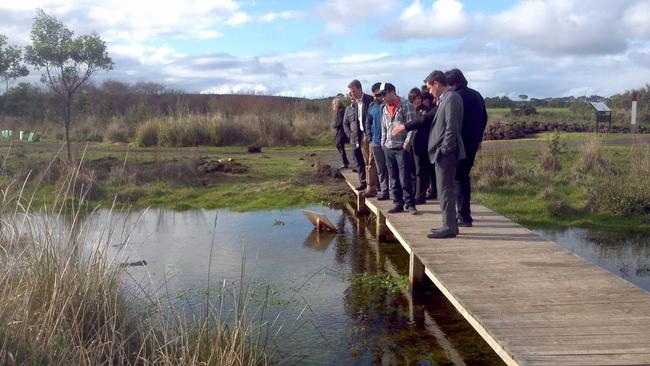
5 Victoria’s newest UNESCO World Heritage jewel lies an hour’s drive northwest of Port Fairy in the Budj Bim National Park, another extinct volcano veined with wetlands and swamps. The Gunditjmara people have lived here for about 60,000 years and the site contains remnants of their stone shelters and extensive fish and eel traps, Australia’s first and largest freshwater stone aquaculture system. Indigenous-led tours explore the park’s man-made and natural features, including crater lakes, lava canals and manna gum woodlands with resident koalas; budjbimtours.net.
-
6 Tiny Yambuk, just 10 minutes by car west of Port Fairy, is full of surprises. It’s home to the Shaw River Buffalo Cheese farm, Icelandic horses (look for them in roadside paddocks) and Australia’s only offshore volcano. Deen Maar, aka Lady Julia Percy Island, is a flat-topped island visible 19km off the coast from the lookout at The Crags coastal reserve. These are the ancestral lands of the Peek Whurrong, the “kelp language” people of Victoria’s southwest coast who believe Deen Maar is the body of Bunjil, the creator. The 129ha island is also home to the world’s largest fur seal colony, with an estimated 30,000 creatures. For a closer look, Southern Coast Charters runs half-day trips; southerncoastcharters.com.au.
-
7 The slightly morbid name of the town’s favourite pizza joint and bar, Coffin Sally, is easily explained. This shopfront on central Sackville Street once housed a carpenter who made the town’s coffins; the laneway behind is still known as Coffin Alley. The bar’s name is a playful take on that. Aside from animal skulls lining the shelves of the restaurant, it’s quite lively inside, with a takeaway counter facing the street, a cosy bar behind, a courtyard with wood burner and the candlelit restaurant at rear. The bestseller of the 20 pizzas on offer is the Buffalo Sally, a piping-hot mess of Napoli sauce, Shaw River buffalo mozzarella, cherry tomatoes and basil. Pair it with a craft beer or a Solerno spritz, mixed with blood orange liqueur, gin, mint and sparkling wine;
coffinsally.com.au.
-
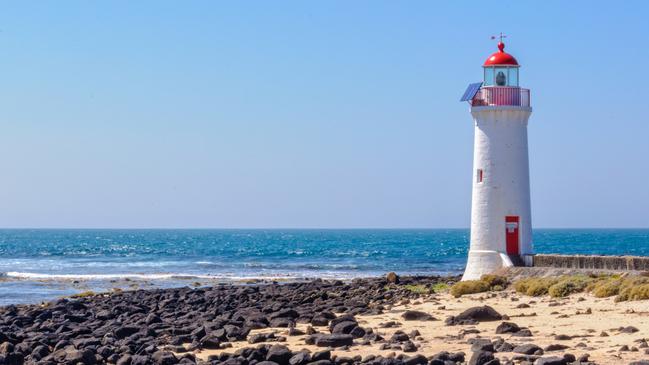
8 At the mouth of the Moyne River lies Griffiths Island, an essential pilgrimage for every Port Fairy visitor. Start at riverside Martin’s Point, where a stone rotunda provides information on the island history — its early days as a whaling station and bluestone quarry, and the breakwater built to protect the town’s commercial fishing fleet. From the breakwater it’s a 3km circuit around the island via its landmark red-and-white lighthouse, which has protected this shipwreck coast since 1859. Walk to the lighthouse via the beach or a boardwalk through tussocked dunes where 40,000 muttonbirds come to breed and nest each summer, and black wallabies congregate at dusk to feed and star in tourist photos; moyne.vic.gov.au.
-
9 Having fish and chips by the beach is a classic Australian ritual and Port Fairy has the perfect ingredients. First stop: East Beach takeaway (146 Griffiths Street) for a wide choice of fried seafood options, from flake and blue grenadier to crumbed prawns and fish cakes, and crisp, salty chips. Take your butcher-papered food parcel up the rise behind where hilltop picnic tables capture sparkling views over the entire turquoise arc of East Beach. Beware wily seagulls.
-
BEST BEDS
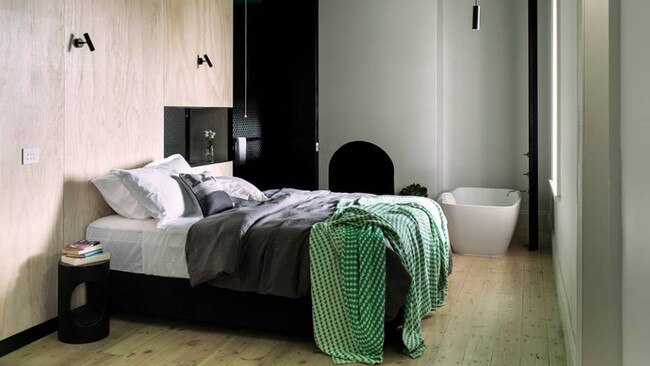
10 In 2013, Melbourne sea-changers Colleen Guiney and John Watkinson revived an empty bluestone mansion on riverside Gipps Street as Drift House, four sharply designed suites with rich textures and grand, 19th-century bones. It gained a swift reputation as Port Fairy’s finest holiday accommodation, a standing that’s sure to grow now the pair have added two new suites in a 1920s Edwardian cottage, surrounded by lawn, lavender beds and a small orchard for an idyllic setting. Each Drift House suite has details that delight and surprise: the doorhandles made from decorative iron fence posts; Creswick alpaca throws; extravagant bathroom tiling, from Spanish houndstooth designs to concave Japanese ceramics that dazzle the eyes; the prize-winning (and complimentary) yo-yos baked by local Sandra Showler. The latest renovations have also added a new guest salon. It’s a luminous space of recycled timbers, soaring glass and salvaged sandstone with a fire-warmed conversation pit, honesty bar and wonderful breakfasts (and coffees) prepared by John using premium regional produce such as organic breads from the Irrewarra Sourdough Bakery near Colac. “Most people who stay with us leave the car and walk everywhere,” says Colleen. “This is really just their recharging time.” It’s excellent advice for all visitors to
Port Fairy.
Kendall Hill was a guest of Drift House.

To join the conversation, please log in. Don't have an account? Register
Join the conversation, you are commenting as Logout